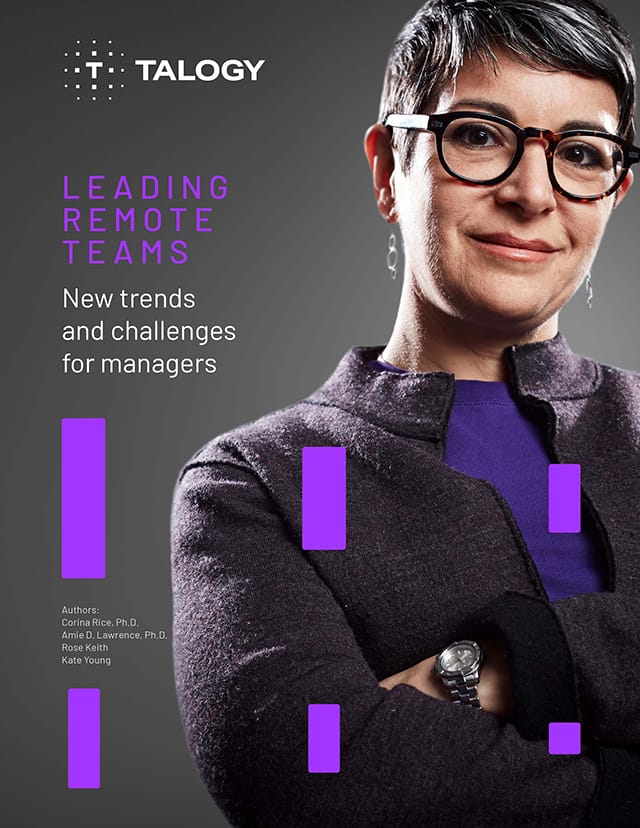Written by Hannah Asbury, Senior Consulting Associate
With the majority of the workforce either working remotely or in a hybrid-remote setting, employee engagement is more important now than ever. It is imperative for employees to feel a sense of belonging to their group and actively engage and interact within their team, especially when working remotely. Because face to face interactions are no longer the ‘norm,’ managers must find ways to increase employee engagement within the virtual workplace.
How can managers engage employees in an impactful and meaningful way? And what does meaningful employee engagement look like? Employee engagement will look different based on the manager and should be driven by the individual needs of the team members and the team as a whole.
Benefits of employee engagement
Why is engagement so important? It has been shown that increasing employee engagement can lead to a decrease in job withdrawal behaviors such as absenteeism and turnover. Employee engagement has also been shown to increase overall productivity and role satisfaction. The Harvard Business Review indicated that organizations with a high level of engagement report up to 22% higher productivity among employees.
There is a general consensus that people don’t quit jobs; they quit managers. This emphasizes the manager’s responsibility to make sure employees feel like they are heard and understood, that they are engaged in their roles and within their team. Employees who feel heard, understood, and connected to their team are more likely to stay with the organization. Conversely, employees who feel disconnected from their manager or their team, unsupported, or disengaged from their role are likely to be the first to abandon ship during challenging times or difficulties experiences, in search of better – i.e., more engaging – opportunities.
How to put employee engagement into practice
What does employee engagement truly look like? Realistically, there is not one ‘right’ answer to this question. When it comes to successful employee engagement, consider the following points:
- Get to know each employee
- Establish two-way communication
- Ensure frequent communication
- Connect team members to one another
- Provide support and resources
- Have fun with it!
Customize your interactions based on the employee’s needs and preferences. Do they prefer to have their camera on or off during meetings? How frequently do they prefer to touch base? What has been working well for them when it comes to their current work set-up? What could be improved?
Continually asking for input can ensure that the line of communication between employee and manager remains open and authentic. Feedback should go both ways; the manager should be able to deliver feedback to the employee in an impactful way, just as the employee should feel comfortable asking their manager for the tools and resources they need to be successful in their role.
Have these kinds of conversations frequently. This means having them more than once a year during an annual review. Because the majority of individuals are still working from home or in a hybrid arrangement, the line of communication between manager and employee must not only remain open but also be encouraged.
This could mean creating a ‘buddy system’ for new hires to ask questions without fear of judgment from their managers. Or, it could simply mean encouraging connections between the existing members of your team. Employees should have a safe space where they feel comfortable discussing topics that they may not want to breach with their manager. These kinds of connections can be just as important for engagement as the connection between employee and manager.
What additional tools or resources does the employee need to feel supported in their job? Do they currently have too much on their plate and feel overwhelmed? What support can the manager provide to alleviate some of that stress? What developmental opportunities are available that align with the employee’s professional and personal goals? It is up to the manager to identify these needs and provide the appropriate support and resources to best serve their employee.
While engaging employees can be productive, it can also be less work-focused. If your team enjoys being active, you might look into a team-based activity that focuses on physical health. A lot of companies offer wellness programs such as step competitions or mindfulness mediation sessions that a manager can take advantage of at low to no cost.
Another option could be online games or trivia as a fun and interactive way to engage your team. Sporcle is known as the World’s Largest Trivia Quiz Website and has a wide range of topics you can choose from depending on your team’s interests. These kinds of activities are especially beneficial because they can be administered to groups of any size, based in any location, in any time zone.
The possibilities for employee engagement are endless. Find what works for you and your team, and don’t be afraid to try new things. Having an open line of communication with your employees will encourage them to ask for the tools and resources that they need to be successful in their roles. It also ensures that they feel heard and understood, thus leading to more engaged and satisfied employees overall.




